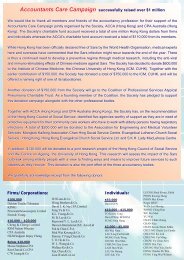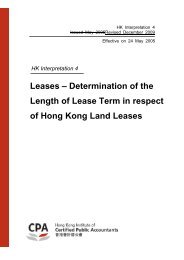Flagship fashion - Hong Kong Institute of Certified Public Accountants
Flagship fashion - Hong Kong Institute of Certified Public Accountants
Flagship fashion - Hong Kong Institute of Certified Public Accountants
Create successful ePaper yourself
Turn your PDF publications into a flip-book with our unique Google optimized e-Paper software.
<strong>Hong</strong> <strong>Kong</strong>’s only functioning<br />
wind power turbine,<br />
Lamma Winds, is <strong>of</strong>ten<br />
barely visible from nearby<br />
islands because <strong>of</strong> the smog.<br />
The single turbine averages 100 kilowatts a<br />
day, barely an eighth <strong>of</strong> its capacity, and an<br />
insignificant proportion <strong>of</strong> the city’s energy<br />
demand – unsurprising for a city that is part<br />
<strong>of</strong> a country still highly reliant on fossil fuels.<br />
The figures are gloomy. Nonrenewable<br />
energy sources account for more than 90 percent<br />
<strong>of</strong> China’s energy consumption, according<br />
to World Bank data. China’s total energy<br />
use rose 7 percent in 2011, the fastest annual<br />
pace in four years, according to the National<br />
Bureau <strong>of</strong> Statistics. (The global average is<br />
an increase <strong>of</strong> just 1.6 percent according to<br />
BP, the British energy giant.)<br />
Nonrenewable energy is dirty energy,<br />
which means China’s air is likely to get worse.<br />
Premier Wen Jiabao announced in March<br />
that the government would stop its “blind”<br />
expansion <strong>of</strong> wind and solar industries,<br />
which have grown sharply in recent years.<br />
Instead, Wen claimed, Beijing would focus<br />
efforts on developing nuclear and hydroelectric<br />
power.<br />
“The economics <strong>of</strong> these renewable energy<br />
sources are still relatively less attractive<br />
than that <strong>of</strong> the fossil fuels,” says Artie Ng, a<br />
fellow at <strong>Hong</strong> <strong>Kong</strong> Polytechnic University’s<br />
public policy research institute and a member<br />
<strong>of</strong> the <strong>Hong</strong> <strong>Kong</strong> <strong>Institute</strong> <strong>of</strong> CPAs.<br />
It is likely Beijing no longer saw the value<br />
<strong>of</strong> paying a premium for electricity produced<br />
from solar and wind. Developers <strong>of</strong> solar<br />
projects get paid a minimum <strong>of</strong> 1 yuan per<br />
kWh and wind power plants receive 0.61<br />
yuan per kWh, while coal fired power plants<br />
receive just 0.30 to 0.40 yuan, according to<br />
Bloomberg New Energy Finance.<br />
Although Wen’s announcement might<br />
not mark an about-face on renewable energy,<br />
it does mean – for the short term at<br />
least – China will import more fossil fuels<br />
as it develops alternative renewables like<br />
nuclear and hydropower. According to a report<br />
in March by the China Electricity Council,<br />
China’s coal fired power output totalled<br />
$113.9<br />
Nuclear<br />
3,825.32 billion kWh in 2011, up 14.8 percent<br />
from a year earlier. Coal still accounts<br />
for about 70 percent <strong>of</strong> China’s energy needs,<br />
according to most estimates. Meanwhile,<br />
the share <strong>of</strong> nonfossil energy consumption<br />
– including solar, wind, nuclear and hydroelectric<br />
power – <strong>of</strong> total energy use in China<br />
declined 0.3 percent from 8.6 percent in<br />
2010 to 8.3 percent in 2011, according to the<br />
National Energy Administration.<br />
“Coal, which is currently the most affordable<br />
fuel for electricity generation, will inevitably<br />
continue to be a part <strong>of</strong> the immediate<br />
energy supply strategy for most developing<br />
countries,” says Mark Takahashi, chief financial<br />
<strong>of</strong>ficer <strong>of</strong> CLP Group.<br />
Perhaps in anticipation <strong>of</strong> the policy<br />
change, solar power producers had already<br />
seen government subsidies withdrawn, and<br />
a number <strong>of</strong> Chinese manufacturers have<br />
collapsed or are in financial trouble and are<br />
seeking buyers. Meanwhile, wind power lost<br />
a lot <strong>of</strong> credibility when reports showed that<br />
energy generated was wasted due to lack<br />
<strong>of</strong> connectivity with the national grid – the<br />
$94.8<br />
Conventional coal<br />
Figures are based on research by the Energy Information Administration in the United States and represent the<br />
total cost <strong>of</strong> building and operating a generating plant over its life cycle. In reality, there could be variations in costs<br />
based on local factors such as the cost <strong>of</strong> labour and fuel and government incentives at the time. The data excludes<br />
energy from oil because the administration expects no new petroleum-fueled plants to be built in the future.<br />
May 2012 33

















